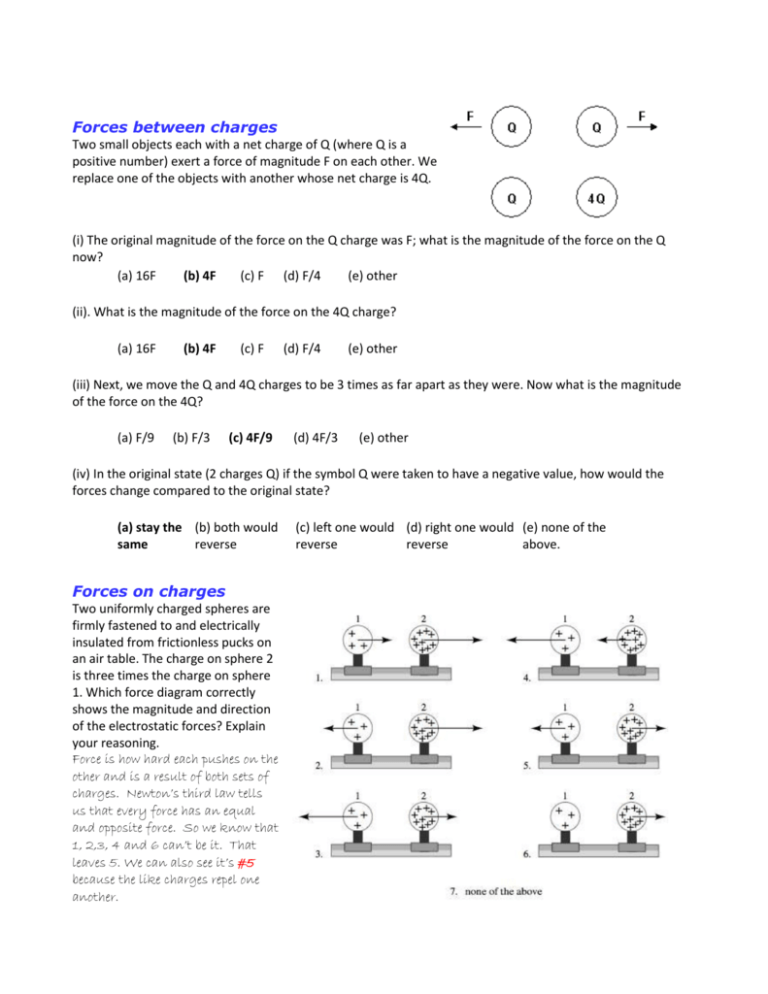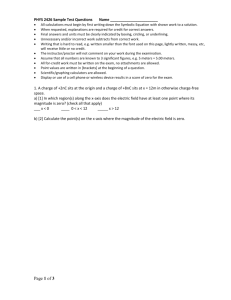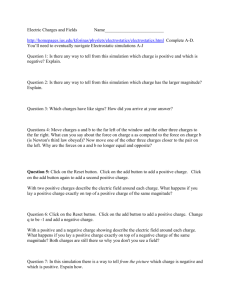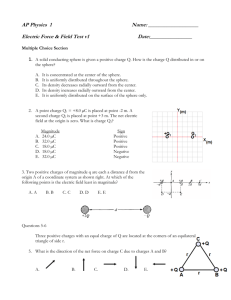Forces between charges Forces on charges
advertisement

Forces between charges Two small objects each with a net charge of Q (where Q is a positive number) exert a force of magnitude F on each other. We replace one of the objects with another whose net charge is 4Q. (i) The original magnitude of the force on the Q charge was F; what is the magnitude of the force on the Q now? (a) 16F (b) 4F (c) F (d) F/4 (e) other (ii). What is the magnitude of the force on the 4Q charge? (a) 16F (b) 4F (c) F (d) F/4 (e) other (iii) Next, we move the Q and 4Q charges to be 3 times as far apart as they were. Now what is the magnitude of the force on the 4Q? (a) F/9 (b) F/3 (c) 4F/9 (d) 4F/3 (e) other (iv) In the original state (2 charges Q) if the symbol Q were taken to have a negative value, how would the forces change compared to the original state? (a) stay the (b) both would same reverse Forces on charges Two uniformly charged spheres are firmly fastened to and electrically insulated from frictionless pucks on an air table. The charge on sphere 2 is three times the charge on sphere 1. Which force diagram correctly shows the magnitude and direction of the electrostatic forces? Explain your reasoning. Force is how hard each pushes on the other and is a result of both sets of charges. Newton’s third law tells us that every force has an equal and opposite force. So we know that 1, 2,3, 4 and 6 can’t be it. That leaves 5. We can also see it’s #5 because the like charges repel one another. (c) left one would (d) right one would (e) none of the reverse reverse above. Thinking about Coulomb's Law In our studies of the force between electric charges, we have constructed an equation to tell us how much force one charge exerts on a second. (If there are many charges exerting forces, we have to add up all those forces to find out the electric force a given charge feels.) One way of writing this equation is in symbols: A second way would be to use words representing the ideas involved rather than symbols in the equation: Is it always more useful to write the equation in symbols, or is there some reason why it might be useful to write - or at least to think about - the equation in the second way? Discuss the value and limitations of each representation. When you solve problems using Coulomb's law, do you always use it in the "symbol form", or does the "idea form" also play a role? This answer depends on the individual. The reason this question was asked was to get you to really think about what the symbols mean. If you do this, then it’s easier to correctly use the equation and it helps you reason out conceptual problems. Accelerating charges* In each of the four cases shown below, a particle of charge +q is placed a distance d from a particle of charge +4q. The particles are then released simultaneously. The masses of the particles are indicated in the diagram. Rank the magnitude of the acceleration of each particle just after it is released from greatest to least. Use the following notation: A>B=C>D means A is greater than B which is equal to C which is greater than D. If any or all of the accelerations are zero specify that explicitly. If the ranking of the magnitude of the accelerations is not possible, state that. In any case, explain your reasoning carefully. First analyze the force that is acting on each charge. The force is determined by the two objects interacting. If you start with Case 1, the charges are q and 4 q with a separation of d. That means the force is 4kqq/d2 . Now look at Case 2. Again a charge of q and 4q a distance d apart so 4kqq/d2, Check cases 3 and 4, they also experience the same force as the charges in Cases 1 and 2 for the same reasons. So now we know we are dealing with the same force on each charge and we can concentrate on the acceleration of each charge. F = ma will help us here. F/m = a. look at each charge individually to see what its acceleration will be. Charge A has a force of 4kqq/d2 and a mass of m so its acceleration is a=4kqq/md2. Charge B also has a mass of m so it has the same magnitude of acceleration as A. Charge C also has a mass m. Charge D actually has a different mass. D has a mass of 3m. This means a = 4kqq/3md2 That’s a third of the acceleration that A, B and C experience. In the end you find: A=B=C=F > D=E=G=H Dependence of E In the figure at the left is shown a fixed charge (specified by a circle) and a location (specified by the x). A test charge is placed at the x in order to measure the electric effect of the fixed charge. Complete the two statements below as quantitatively as you can. (For example, if the result is larger by a factor of three don't say “increases” say “triples” or “is multiplied by three”.) Each statement is meant to be compared with the original situation. (The changes don't cumulate.) a. If the test charge is replaced by one with half the amount of charge, then the electric field it sees will not change. b. If the fixed charge is replaced by one with twice the amount of charge, then the electric field seen by the test charge will not change. Functional dependence and the electric field* 1. (a) Suppose you want to purchase a sweater, in Denver, which has a list price of $40 for which you pay $2 in sales tax. Suppose your friend bought the same sweater, in Denver, but it had a list price of $80 for which she paid $4 in sales tax. How does the ratio of sales tax to price of the sweater compare for you and your friend (i.e. compare the ratios (sales tax)/(sweater price)? What does that ratio tell us? What is that ratio defined as? $2/$40 = 1/20 $4/$80 = 1/20 The ratios are equal and tell us what the tax rate is on sweaters. 1/20 = 5% which is the percent sales tax. (b) Suppose a charge exerts a repulsive force of 4 newtons on a test charge of 0.2 microcoulombs that is brought within 2 cm of it. However, the charge exerts a repulsive force of 8 newtons on a test charge of 0.4 microcoulombs that is brought within 2 cm of it. How does the ratio of the force on the test charge to the test charge, itself, compare in each case (i.e. compare (force felt by test charge)/(test charge) in each case)? What does that ratio tell us? What is that ratio defined as? 4N/0.2 mC = 2 x 107 N/C 8N/0.4 mC = 2 x 107 N/C This ratio tells us how much force per coulomb of charge will be felt. This is the Electric Field. (c) Suppose a charge Q exerts a force F on a test charge q that is brought near to it. By how much would the force exerted by Q increase if the test charge increased by a factor of a, where a can be any constant (i.e. a = 17 or 5 or 7.812, etc.)? By how much would the ratio of the force on the test charge to the test charge, itself, increase if the test charge increased by a factor of a? Explain. It would increase by a. The ratio found in (bb) above would not change since the force increases by the same factor as the charge. Electric fields are not affected by the test charge. (d) When the value of one quantity depends on the value a second quantity (and perhaps on others), we say that the first quantity is a function of the second. How the first quantity changes when the second changes is called the functional dependence. For example, if t = As, we say that t has a linear functional dependence on s. When s doubles, so does t. If s is divided by 10, so is t. As a second example, if we had y = Bx2, we would say that y depends quadratically on x. If x doubles, y quadruples. If x is divided by 10, then y is divided by 100. (Try this with some numbers, picking whatever values of the constants A and B you would like.) (i) What is the functional dependence of the sales tax paid on the price of the sweater? Explain. Write an equation that relates the tax paid (t) to the cost of the sweater (s). t = 1/20s (ii) What is the functional dependence of the sales tax percentage rate on the price of the sweater? Explain. There is no dependence between these two. Tax percentage is the same for all sweaters. (iii) In part (c), what is the functional dependence of the force, F on the magnitude of the test charge, q? Explain. It is linear. When the test charge doubles, the force also doubles. (iv) What is the functional dependence of the electric field established by Q, EQ, on the test charge, q? Explain. E = AQ Electric field does not have a functional dependence on the test charge. Charge from field lines The figures at the right show some representative electric field lines associated with some charges. Both pictures show the same charges and field lines, but they are masked in different ways by imaginary closed surfaces drawn for the purpose of hiding the charges from your view. A) From the field lines in the two pictures, which of the following statements is most likely to be true? a. There are no charges contained in A. b. The charge contained in A is positive. c. The charge contained in A is negative. d. The total charge contained in A is zero. e. None of the above can be true. B) From the field lines in the two pictures, which of the following statements is most likely to be true? a. There are no charges contained in B. b. The charge contained in B is positive. c. The charge contained in B is negative. d. The total charge contained in B is zero. e. None of the above. C) From the field lines in the two pictures, which of the following statements is most likely to be true? a. b. c. d. e. The charge contained in C is positive and greater in magnitude than the charge in B. The charge contained in C is positive and smaller in magnitude than the charge in B. The charge contained in C is negative and greater in magnitude than the charge in B. The total charge contained in C is negative and smaller in magnitude than the charge in B. None of the above. D) From the information in the two pictures, what can you say about the electrostatic potential at a point on the surface of box B compared to the electrostatic potential on the surface of box C? a. The potential of any point on the surface of B is higher than the potential of any point on the surface of C. b. The potential of any point on the surface of C is higher than the potential of any point on the surface of B. c. The potential on the surface B and C are the same. d. Some of the points on B will be at a higher potential than some of the points on C, but not all of them. e. Nothing can be determined about the relative potentials. Orienteering an electric potential 1. (a) The figure on the right shows a contour plot of a piece of a range of hills in Virginia. The outer part of the figure is at sea level (marked 0). Each contour line from the region marked zero shows a level 10 m higher than the previous. The maximum height is 70 m and is shown by the number 70. Answer the following questions by giving the pair of grid markers (a letter and a number) closest to the point being requested. i. ii. iii. iv. v. vi. Where is there a steep cliff? B2 Where is there a pass between two hills? C3 Where is the easiest climb up the hill? From G7 to D4 (b) Now suppose the figure represents instead a plot of the electric equipotentials for the surface of a glass plate. The numbers now represent voltage. The maximum is 70 V and each contour line from the region marked zero shows a level 10 V higher than the previous. i. Where would a test charge placed on the glass feel the strongest electric force? In what direction would it point? ii. iii. iv. Along the steep cliff. Is there a place on the glass where a charge could be placed so it feels no electric force? Where? Yes, in the pass at C3 and also at the top of both plateaus. One is marked 70 and the other is empty just below it. Also at sea level – everywhere marked with a 0 potential.









